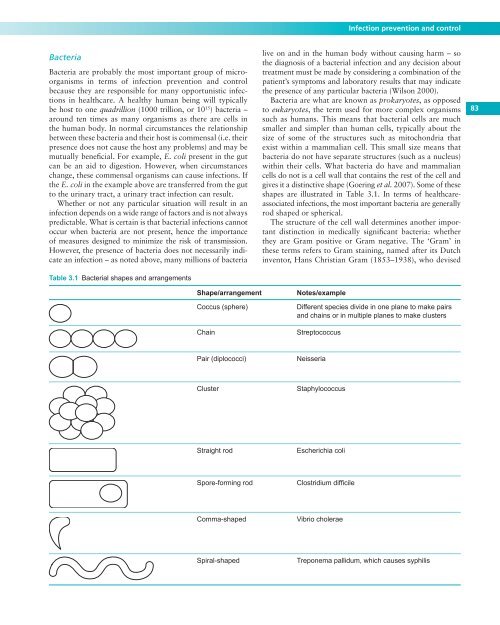Infection prevention and control - Royal Marsden Manual of Clinical ...
Infection prevention and control - Royal Marsden Manual of Clinical ...
Infection prevention and control - Royal Marsden Manual of Clinical ...
You also want an ePaper? Increase the reach of your titles
YUMPU automatically turns print PDFs into web optimized ePapers that Google loves.
Bacteria<br />
Bacteria are probably the most important group <strong>of</strong> microorganisms<br />
in terms <strong>of</strong> infection <strong>prevention</strong> <strong>and</strong> <strong>control</strong><br />
because they are responsible for many opportunistic infections<br />
in healthcare. A healthy human being will typically<br />
be host to one quadrillion (1000 trillion, or 10 15 ) bacteria –<br />
around ten times as many organisms as there are cells in<br />
the human body. In normal circumstances the relationship<br />
between these bacteria <strong>and</strong> their host is commensal (i.e. their<br />
presence does not cause the host any problems) <strong>and</strong> may be<br />
mutually benefi cial. For example, E. coli present in the gut<br />
can be an aid to digestion. However, when circumstances<br />
change, these commensal organisms can cause infections. If<br />
the E. coli in the example above are transferred from the gut<br />
to the urinary tract, a urinary tract infection can result.<br />
Whether or not any particular situation will result in an<br />
infection depends on a wide range <strong>of</strong> factors <strong>and</strong> is not always<br />
predictable. What is certain is that bacterial infections cannot<br />
occur when bacteria are not present, hence the importance<br />
<strong>of</strong> measures designed to minimize the risk <strong>of</strong> transmission.<br />
However, the presence <strong>of</strong> bacteria does not necessarily indicate<br />
an infection – as noted above, many millions <strong>of</strong> bacteria<br />
Table 3.1 Bacterial shapes <strong>and</strong> arrangements<br />
<strong>Infection</strong> <strong>prevention</strong> <strong>and</strong> <strong>control</strong><br />
live on <strong>and</strong> in the human body without causing harm – so<br />
the diagnosis <strong>of</strong> a bacterial infection <strong>and</strong> any decision about<br />
treatment must be made by considering a combination <strong>of</strong> the<br />
patient’s symptoms <strong>and</strong> laboratory results that may indicate<br />
the presence <strong>of</strong> any particular bacteria ( Wilson 2000 ).<br />
Bacteria are what are known as prokaryotes , as opposed<br />
to eukaryotes , the term used for more complex organisms<br />
such as humans. This means that bacterial cells are much<br />
smaller <strong>and</strong> simpler than human cells, typically about the<br />
size <strong>of</strong> some <strong>of</strong> the structures such as mitochondria that<br />
exist within a mammalian cell. This small size means that<br />
bacteria do not have separate structures (such as a nucleus)<br />
within their cells. What bacteria do have <strong>and</strong> mammalian<br />
cells do not is a cell wall that contains the rest <strong>of</strong> the cell <strong>and</strong><br />
gives it a distinctive shape ( Goering et al. 2007 ). Some <strong>of</strong> these<br />
shapes are illustrated in Table 3.1 . In terms <strong>of</strong> healthcareassociated<br />
infections, the most important bacteria are generally<br />
rod shaped or spherical.<br />
The structure <strong>of</strong> the cell wall determines another important<br />
distinction in medically signifi cant bacteria: whether<br />
they are Gram positive or Gram negative. The ‘Gram’ in<br />
these terms refers to Gram staining, named after its Dutch<br />
inventor, Hans Christian Gram (1853–1938), who devised<br />
Shape/arrangement Notes/example<br />
Coccus (sphere) Different species divide in one plane to make pairs<br />
<strong>and</strong> chains or in multiple planes to make clusters<br />
Chain Streptococcus<br />
Pair (diplococci) Neisseria<br />
Cluster Staphylococcus<br />
Straight rod Escherichia coli<br />
Spore-forming rod Clostridium diffi cile<br />
Comma-shaped Vibrio cholerae<br />
Spiral-shaped Treponema pallidum , which causes syphilis<br />
83


